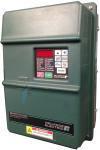About the 25G2160
The 25G2160 is a GV3000/SE 25 HP AC Drive from Reliance Electric. The 25G2160 may have also been mass-produced by Asea Brown Boveri or Baldor Reliance at one point, but it has since been discontinued by all of its original manufacturers. AX Control does make an effort to keep the 25G2160 stock even though it has become difficult to locate now.
The 25G2160 is a General Purpose (V/Hz) only regulated drive that is 200-230 volts. This particular drive has version 6.0 regulator firmware, and is encased by a NEMA 12 style enclosure. This enclosure protects the internal circuitry from hazardous parts and has the ability to provide a small degree of protection from falling dirt or debris. This enclosure should be used in indoor applications away from all liquids, corrosive or combustible materials, and dust. This drive has a small tab on its faceplate that will give the user access to an RS-232 female 9-pin port. This port is found on the regulator card behind the built-in keypad.
This drive, as with any number of refurbished or vintage Reliance Electric GV3000 series drive, can encounter the occasional fault in function. One fault that seems to plague owners of the 25G2160 drive specifically is the motor output phase loss fault, designated as the fault code OPL on the drive's built in display interface. This fault occurs in the 25G2160 drive due to a loss of phase between the drive and its corresponding motor, and corrective action when faced with this fault includes checking the connections and cables of all three drive phases and motor windings, making sure to replacing any damaged cable as you go. More information on GV3000 drive programming and fault code troubleshooting is available online with Reliance Electric's Software Start-Up and Reference Manual D2-3359-6.
The user interface of the 25G2160 has 14 LED indicators, 9 keys, and a 7-segment 4-digit LED display. There is also an external fan assembly on this drive that helps to force air to the internal circuitry of the drive. There are also vents on the back and bottom of the drive that allows for extra air circulation. There are brackets on the back of the drive that can be used along with bolts and washers to help attach the drive onto its mounting surface.









